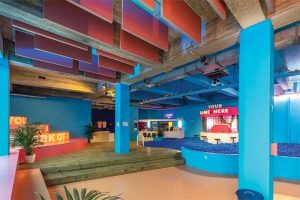Specifying suspended acoustic baffles
by brittney_cutler | November 30, 2021 12:14 pm
 [1]
[1]The need to decrease indoor noise levels and improve auditory comfort, speech intelligibility, and sound privacy by specifying high-performing, sound-absorbing surfaces or objects is well-established in building standards, guidelines, and rating systems. Building owners and occupants expect their spaces to function well acoustically, even if they do not verbalize this during the design phase or the building is not required to comply with any specific acoustics standard.
Many specifiers can search a guideline or standard for the minimum ceiling noise reduction coefficient (NRC) requirement, then select and specify an appropriate acoustical ceiling panel system based on the NRC rating on the manufacturer’s data sheet. It can become much more perplexing, though, when a suspended acoustical ceiling is not part of the design aesthetic, the applicable standard or established performance goal is expressed in terms of NRC, and the alternative overhead sound absorbing objects do not have NRC ratings.
There are many alternative design options for implementing sound absorption over spaces when an acoustic ceiling is not desired. Vertical sound baffles and banners, and horizontal islands and clouds can be suspended as floating elements for greater visual impact. While many design options exist, the use of NRC rating as a performance metric does not. The sound-absorbing performance of these individual, hanging, acoustic objects is not quantified using NRC. Instead, their absorption is characterized using sabins, the unit of sound absorption. The number of sabins is reported and specified per object and is dependent on its size. Sabins should be specified by octave band or third octave band from at least the 125 hertz (Hz) octave band through the 4 kilohertz (kHz) octave band.
The conversion from a single-number NRC requirement found in a standard to sabins of absorption in a specification requires proper discussion with mathematical examples.
Standards and guidelines
Most building design standards, guidelines, and rating systems now have an acoustics requirements section. While not all include the same broad acoustic themes, invariably, they do all include interior sound absorption. The preferred metric for sound absorption is either minimum ceiling NRC or maximum reverberation time (RT60). The former is a performance metric for a product or material, such as an acoustic ceiling panel. The latter is a room performance metric achieved a number of different ways using different materials on different surfaces. Minimum ceiling NRC is more straightforward for architects and specifiers to use because manufacturers typically publish NRC values of their products. RT60 requires complex take offs and calculations and can only be verified by conducting acoustic measurements with instrumentation after construction—far beyond the capabilities of most architects and specifiers.
Version 2 of the WELL Building Standard (WELL v2) by the International WELL Building Institute (IWBI) requires learning spaces to have a minimum ceiling NRC of 0.90 to gain the full two credits available in feature S05 of the Sound Concept. Additional points can be credited in feature S04 for also having an RT60 no greater than 0.60 seconds in rooms less than 283.2 m3 (10,000 cf). The Green Globes Assessment Protocol for Commercial Buildings by the American National Standards Institute (ANSI) and the Green Building Initiative (GBI) (ANSI/GBI 01-2019) requires open office areas to have a minimum ceiling NRC of 0.90 or a maximum RT60 of 0.40 seconds. Unlike WELL v2, which offers points for meeting the NRC requirement and additional points for meeting the RT60 requirements, Green Globes offers points for either, but not both, compliance paths.
Other standards, guidelines, and rating systems use NRC or RT60 exclusively. For example, Acoustical Performance Criteria, Design Requirements, and Guidelines for Schools, Part 1: Permanent Schools by ANSI and the Acoustical Society of America (ANSI/ASA S12.60) only uses maximum reverberation time. A core learning space less than 283.20 m3 (10,000 cf) must have a reverberation time no greater than 0.60 seconds. A minimum ceiling NRC compliance path is not provided. Conversely, the National Institutes of Health (NIH) Design Requirements Manual designates ceilings have a minimum NRC rating. Reverberation time is not used. Since building standards, guidelines, and rating systems use minimum ceiling NRC and/or maximum RT60, specifiers and designers are not used to acousticians and more savvy manufacturers telling them NRC does not apply to acoustical objects like baffles, banners, clouds, and islands. As a result, there is a potential knowledge gap between selecting and specifying these types of sound absorbers and knowing the intent of the acoustics requirements in the standards, expressed in NRC or RT60, are being met.
Dissecting reverberation time
Understanding the components of RT60 is important for understanding how absorption is measured in laboratories, specified properly in construction documents, and how absorption coefficients, NRC, sabins, and RT60 all relate.
RT60 = C (V)
A
RT60 Reverberation time (seconds)
C
Constant (0.161 when V is in m3; 0.049 when V is in cf)
V
Volume of the room (average height x average width x average length)
A
Total sound absorption (sabins) provided by a product sample during testing or by the surfaces and objects in a room if calculating RT60
Complying with RT60 requirements in standards
When the acoustic performance metric in a standard is maximum RT60, the value of RT60 is given, C is known, and V is known through simple room take offs and calculation. One solves for A, the amount of absorption needed in the room to achieve the required RT60 in the standard.
RT60 = 0.60
Most standards require RT60 to be 0.60 seconds or less
RT60 = (0.049xV)/A
A = (0.049 x 10,000)/0.60
Assume the volume of the room is 283.17 m2 (10,000 sf) for this example
A = 817 sabins
817 sabins of absorption are needed in the room to comply with the maximum RT60 requirement in the standard
 [2]
[2]Measuring product absorption
When measuring the absorption performance of a material, product, or object in a reverberation chamber in an acoustics laboratory, RT60 is measured and therefore known, C is known, and V for the test chamber is known based on its dimensions. One solves for A, the total absorption (sabins) provided by the specimen being tested. If the test specimen is representative of a surface finish, such as carpeting on a floor or a contiguous acoustic panel ceiling, then one divides A by the area of the test specimen to get α, the absorption coefficient (refer to ASTM C423, paragraph 12.1.3.).
A = 61 sabins
A came from measuring RT60 in the lab and using the reverberation time equation to solve for A. Sixty-one is used as a hypothetical value for this example.
a = A/area
Divide A by the area of the test specimen to get a
a = 61/72
Insert the numbers for the variables and calculate
a= 0.85
a (alpha, absorption coefficient) is what manufacturers use to calculate NRC
To find α, it is important for one to know the area of the test specimen. For materials or products representing a contiguous room surface, the area of the test specimen is easy to calculate. This is not the case for three-dimensional objects suspended freely inside the test chamber or sitting on the test chamber floor, especially when there are multiple objects arranged in a specific pattern, such as an array. Before discussing this in more detail, a few other fundamental topics need to be covered.
 [3]
[3]Being frequency specific
Materials and surfaces absorb different amounts of sound at different frequencies. Most materials absorb more high-frequency sounds, above 500 Hz, and less low-frequency sounds. This is because the wavelengths of the high-frequency sounds are small, and most room acoustic absorbers are relatively thin. As frequency decreases, the lengths of the sound waves increase. At a point, the thin absorbers barely affect the low-frequency sound at all. Therefore, RT60 is measured at different frequencies at one-third octave band resolution from the 125 Hz octave band through the 4 kHz octave band. The result of the absorption test is not a single A, as in the example above, but instead a set of frequency-dependent values of A, and correspondingly, a set of frequency-dependent values of α. Below is an example of the set of absorption coefficients for a 16-mm (0.625-in.) thick, high-performing, stone wool ceiling panel.
How an NRC rating is calculated
NRC, which is commonly used in standards, specifications, and product data sheets, is found by simply calculating the average of α at four frequency bands—250 Hz, 500 Hz, 1 kHz, and 2 kHz (identified by the red boxes in the chart on page 41)—and rounding to the nearest 0.05.
NRC = (a250 + a500 + a1000 + a2000)) / 4
NRC = (0.82 + 0.69 + 0.87 + 0.94) / 4
NRC = 0.83, which rounds up to 0.85
Why acoustic baffles cannot have an NRC rating
To calculate NRC, α at the 250 Hz, 500 Hz, 1 kHz, and 2 kHz octave bands must be known. For α to be calculated from A, the surface area of the test specimen must be known. For products, such as carpeting and ceiling panels representing a room surface, this is easy; multiply the length of the test specimen by the width of the test specimen. Unfortunately, there is currently no agreed upon method of calculating the effective surface area of sound-absorbing objects or a pattern of objects inside a room, whether they are hanging from the structure above or sitting on the floor.
An analogy of this dilemma is trying to find the cost per square meter or square foot of a chair. The cost of the chair is easy. This is synonymous with the value of A, or total absorption, of the chair. It is found inside the reverberation chamber and reported in sabins. But how does one calculate the area of a chair? How does the chair industry develop a universal method for all the various types of chairs, especially when some chair manufacturers have been using their own method for years and all their literature is based on it?
Similarly, how does one calculate the effective area of an array of sound baffles or banners? There is no standard or universal method. One method would be to include only one side of the baffle, which results in a smaller area, and an illogically high value of α and NRC rating. Another method is to include all surfaces and edges in the area calculation, but this results in oddly low values of α and NRC ratings. Therefore, three-dimensional, sound-absorbing objects inside the boundary surfaces of the room cannot have α values or NRC ratings.
 [4]
[4]How to properly specify sound-absorbing objects
The absorption performance of sound-absorbing objects, such as baffles, banners, islands, and clouds (theatre seats, too) should be reported and specified using frequency-specific sabins of absorption per object. (Refer to ASTM C423, paragraph 12.1.4.) An example of a specification for the absorption performance of a 0.6- x 1.2-m x 51-mm (2- x 4-ft x 2-in.) thick acoustic stone wool baffle is provided below.
2.30 sound absorption (J mount)
Hz 125 250 500 1000 2000 4000
sabins 3.50 4.00 7.10 8.50 8.40 7.80
Some manufacturers do report the absorption performance of their sound-absorbing objects, such as baffles, in terms of NRC. This is incorrect and not a valid method of comparing their absorption performance to other products, or to the NRC or RT60 requirements in building standards, guidelines, or rating systems. They have obscured the useful absorption information about their products. Other manufacturers only report a single sabin number without any indication to which frequency band it applies. For example, if the reported absorption of a baffle is 6.0 sabins—a single number with no frequency information—how does one compare it to the proper specification shown above with sabins of absorption for each octave band? In the lower frequencies, the baffle designated as having 6.0 sabins of absorption outperforms the stone wool baffle above. Conversely, the stone wool baffle has better absorption performance in the upper four octave bands.
Intent of the standards
When a standard, guideline, or building rating system requires a minimum ceiling NRC—for example, NRC 0.90 in open offices—the intent is not to limit design options and force architects and specifiers to use standard, suspended, acoustic panel ceilings when they may not align with the desired aesthetics. The intent is to ensure there is enough sound absorption overhead, so students can understand their teachers, patients can sleep and recover more quickly, and workers can be productive, accurate, and comfortable. One option to comply with the intent of the standard is to use a suspended, acoustic stone wool ceiling panel with an NRC rating of 0.90 or higher. But the intent of the requirement in the standard can be met with numerous other design approaches, including vertically hung baffles and horizontally hung clouds or islands.
The proper approach to ensuring the intent of the standard is being met does not involve trying to get manufacturers who are correctly reporting the performance of their sound-absorbing objects in sabins to arbitrarily create an NRC rating for their products. Instead, the correct approach is to simply calculate how many sabins of absorption a ceiling with an NRC rating of 0.90 would provide and ensure the alternative sound-absorbing objects are providing at least the same amount of absorption. An example is provided below.
Requirement For maximum points, the WELL Building Standard requires a minimum ceiling NRC of 0.90 above open offices.
Option 1
Select and specify a high-performing, acoustic stone wool ceiling panel with an NRC rating of 0.90, 0.95, or higher.
Option 2
Calculate the sabins of absorption provided by the ceiling in Option 1. If the open office is 92.9 m2 (1000 sf), multiply the ceiling panel NRC of 0.90 by the floor area of 92.9 m2 to produce the 900 sabins of absorption provided by the high NRC ceiling. Next, find out how many sabins of absorption will be provided by each of the preferred acoustic baffles. One option is to average the sabins of absorption provided by the baffle at the 250, 500 1000, and 2000 Hz octave bands, which covers the same frequency range as does NRC. If each baffle, such as the 0.6- x 1.2-m x 51-mm (2- x 4-ft x 2-in.) thick acoustic stone wool baffle in the example above, provides 8.0 sabins of absorption (average of 250 to 2000 Hz octave bands), then 113 of those specific baffles would be required over the open office area to provide the equivalent amount of sound absorption as the NRC 0.90 ceiling, and to comply with the NRC requirement in the WELL Building Standard.

How to position acoustics baffles
The main consideration when laying out suspended acoustic objects, such as baffles, islands, and clouds, is the total number of objects needed to achieve the total amount of sound absorption required. The NRC 0.90 requirement in the open office example above resulted in needing 113 baffles. The other main consideration is to somewhat distribute the baffles uniformly over the whole open office area. Do not cluster them closely in the center. Do not locate them all on one side or only around the perimeter.
Orientation, spacing, and height of the baffles are not critical, especially in an open office environment. Often these design aspects are determined by other factors, such as aesthetics, structure location, duct location, avoiding shadows from lighting, and not interfering with the distribution patterns of fire suppression systems. The acoustic objects do not need to be oriented the same or at the same height. Too often suspended acoustic absorbers such as baffles are all aligned, positioned at the same height, and spaced equally. For greater visual impact without any degradation to the acoustic performance, these suspended acoustic elements can be arranged in creative three-dimensional sculptures.
- [Image]: https://www.constructionspecifier.com/wp-content/uploads/2021/11/Rockfon_FL-GenslerTampa_HalkinMason-6777.jpg
- [Image]: https://www.constructionspecifier.com/wp-content/uploads/2021/11/Rockfon_MO-SolarSpectrum_ChadJackson-6165.jpg
- [Image]: https://www.constructionspecifier.com/wp-content/uploads/2021/11/Rockfon_MN-MMAoffice_RHoepner-7867.jpg
- [Image]: https://www.constructionspecifier.com/wp-content/uploads/2021/11/Rockfon_GA-AIAatlanta_PebblePhotog-4559.jpg
Source URL: https://www.constructionspecifier.com/specifying-suspended-acoustic-baffles/
 Gary Madaras, PhD, is an acoustics specialist at Rockfon. He helps designers and specifiers learn the optimized acoustics design approach and apply it correctly to their projects. He is a member of the Acoustical Society of America (ASA), the Canadian Acoustical Association (CAA), and the Institute of Noise Control Engineering (INCE). Madaras can be reached at gary.madaras@rockfon.com.
Gary Madaras, PhD, is an acoustics specialist at Rockfon. He helps designers and specifiers learn the optimized acoustics design approach and apply it correctly to their projects. He is a member of the Acoustical Society of America (ASA), the Canadian Acoustical Association (CAA), and the Institute of Noise Control Engineering (INCE). Madaras can be reached at gary.madaras@rockfon.com.